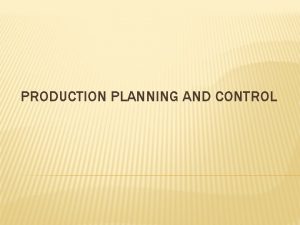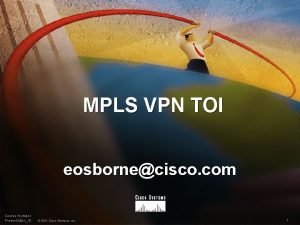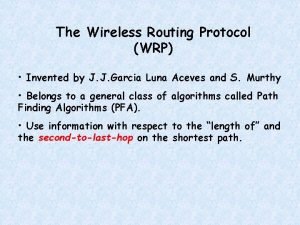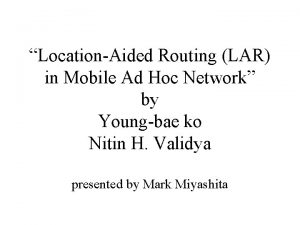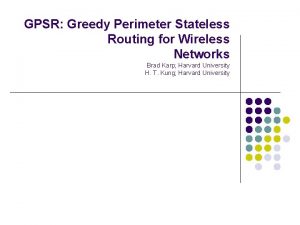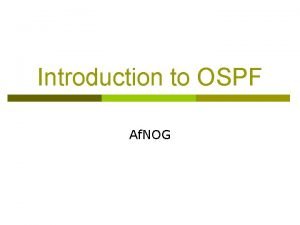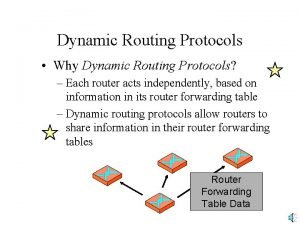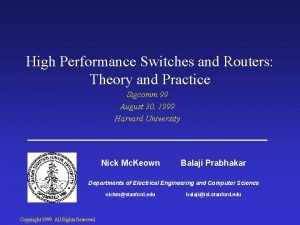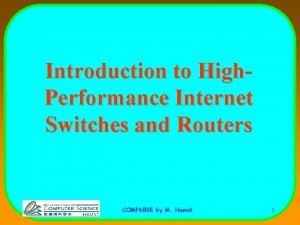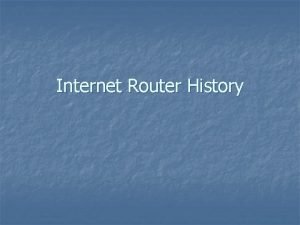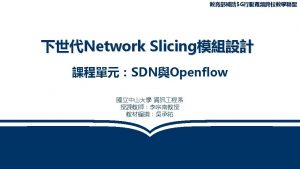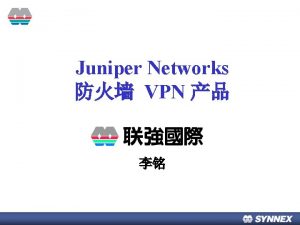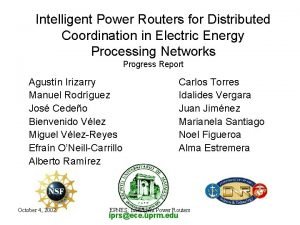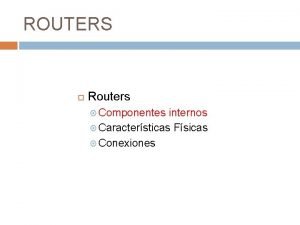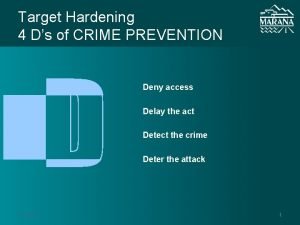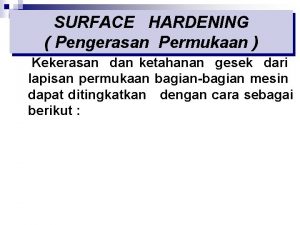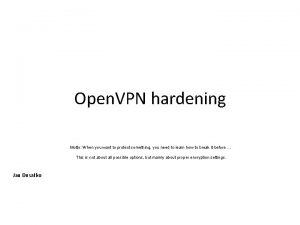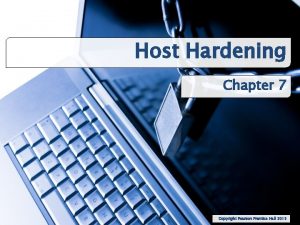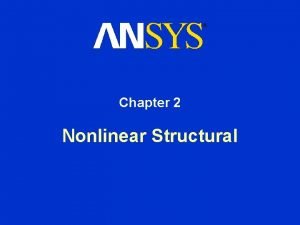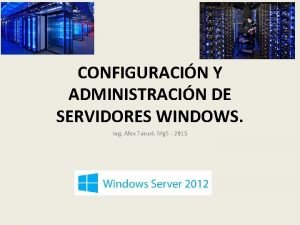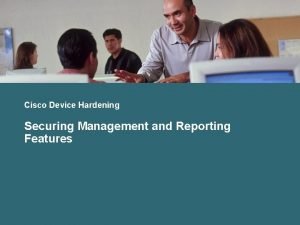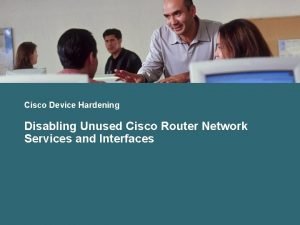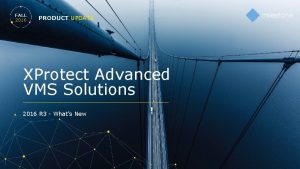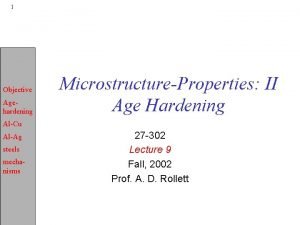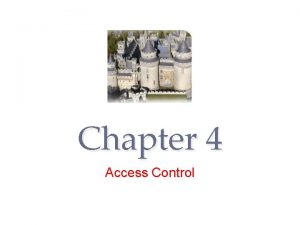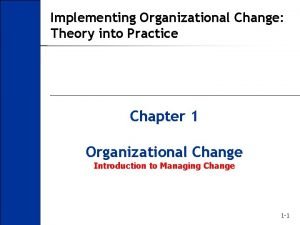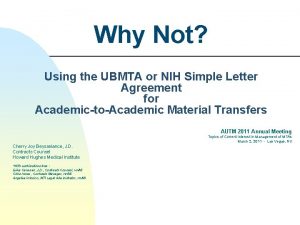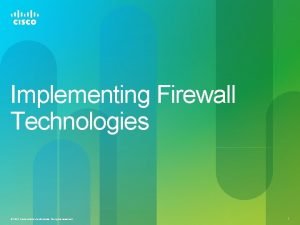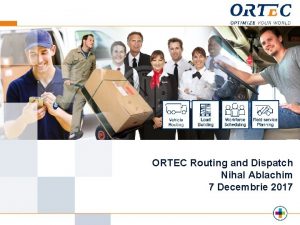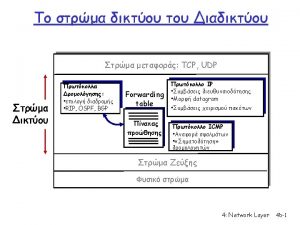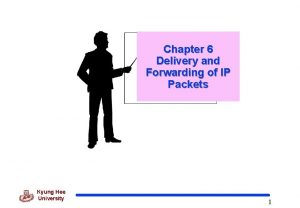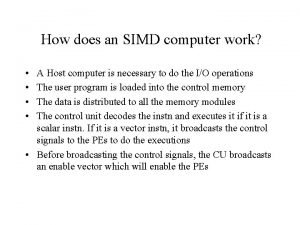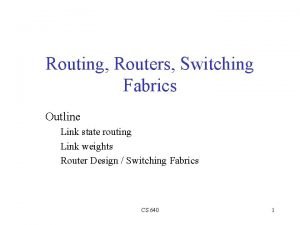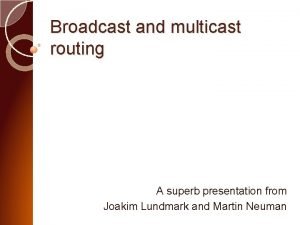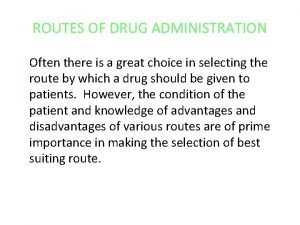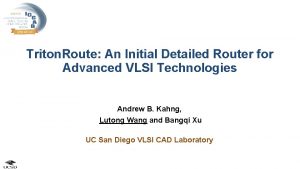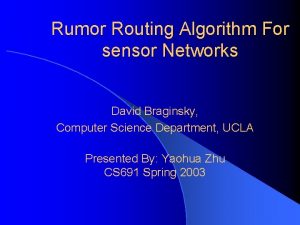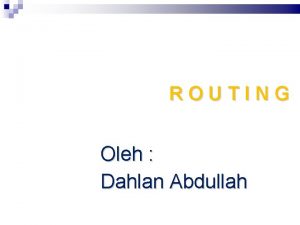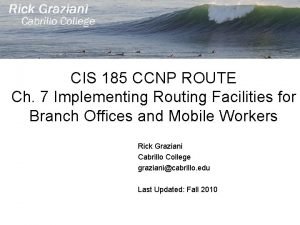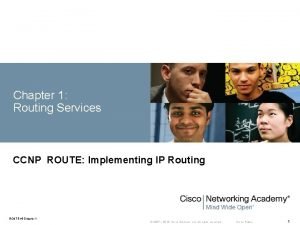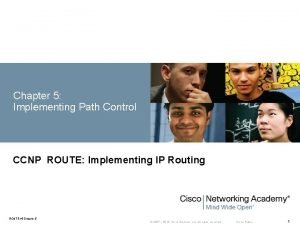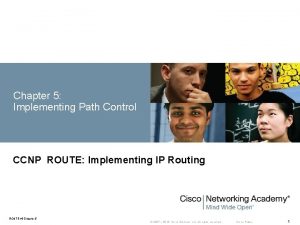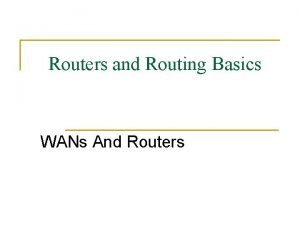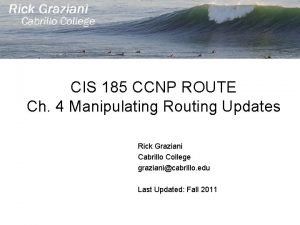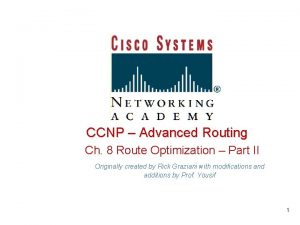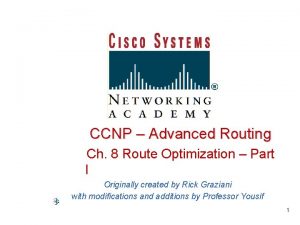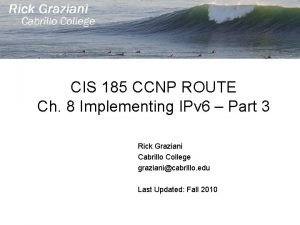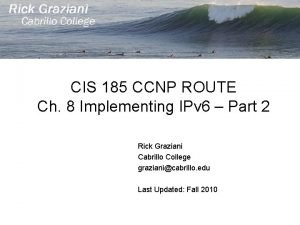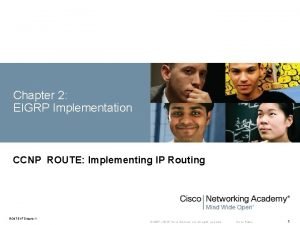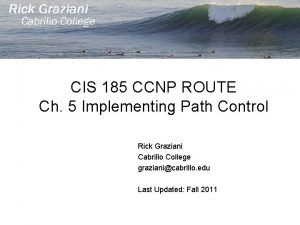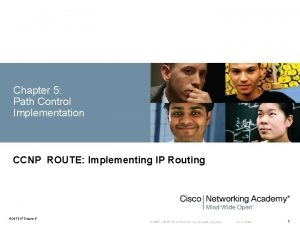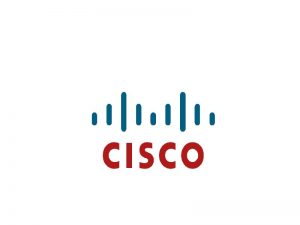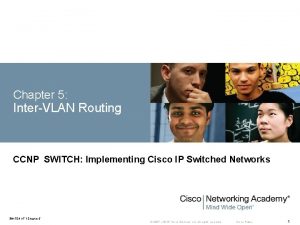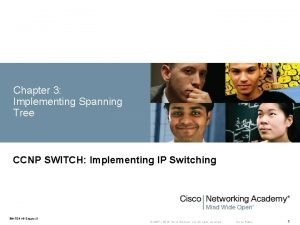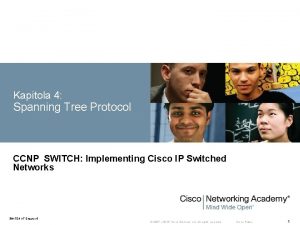Routers and Routing Protocol Hardening CCNP ROUTE Implementing















































































































- Slides: 111

Routers and Routing Protocol Hardening CCNP ROUTE: Implementing IP Routing ROUTE v 7 Chapter 8 © 2007 – 2016, Cisco Systems, Inc. All rights reserved. Cisco Public 1

Chapter 8 Objectives This chapter covers the following topics: § Securing the Management Plane on Cisco Routers § Describing Routing Protocol Authentication § Configuring Authentication for EIGRP § Configuring Authentication for OSPFv 2 and OSPFv 3 § Configuring Authentication for BGP peers § Configuring VRF-lite Chapter 8 © 2007 – 2016, Cisco Systems, Inc. All rights reserved. Cisco Public 2

Chapter 8 Objectives A router’s operational architecture can be categorized into three planes: § Management plane • This plane is concerned with traffic that is sent to the Cisco IOS device and is used for device management. Securing this plane involves using strong passwords, user authentication, implementing role-based command-line interface (CLI), using Secure Shell (SSH), enable logging, using Network Time Protocol (NTP), securing Simple Network Management Protocol (SNMP), and securing system files. § Control plane • This plane is concerned with packet forwarding decisions such as routing protocol operations. Securing this plane involves using routing protocol authentication. § Data plane • This plane is also known as the forwarding plane because it is concerned with the forwarding of data through a router. Securing this plane usually involves using access control lists (ACLs). Chapter 8 © 2007 – 2016, Cisco Systems, Inc. All rights reserved. Cisco Public 3

Securing the Management Plane on Cisco Routers Chapter 8 © 2007 – 2016, Cisco Systems, Inc. All rights reserved. Cisco Public 4

Securing the Management Plane on Cisco Routers Device hardening tasks related to securing the management plane of a Cisco router, including the following: § Following the router security policies § Securing management access § Using SSH and ACLs to restrict access to a Cisco router § Implement logging § Securing SNMP § Backup configurations § Using network monitoring § Disabling unneeded services Chapter 8 © 2007 – 2016, Cisco Systems, Inc. All rights reserved. Cisco Public 5

Securing the Management Plane Step 1. § Follow the written router security policy. § The policy should specify who is allowed to log in to a router and how, who is allowed to configure and update the router, or who is allowed to perform logging and monitoring actions. § The policy should also specify the requirements for passwords that are used to access the router. Chapter 8 © 2007 – 2016, Cisco Systems, Inc. All rights reserved. Cisco Public 6

Securing the Management Plane Step 2. § Secure physical access. § Place the router and physical devices that connect to it in a secure locked room that is accessible only to authorized personnel. § The room should also be free of electrostatic or magnetic interference, have fire suppression, and controls for temperature and humidity. § Install an uninterruptible power supply (UPS) and keep spare components available. § This reduces the possibility of a network outage from power loss. Chapter 8 © 2007 – 2016, Cisco Systems, Inc. All rights reserved. Cisco Public 7

Securing the Management Plane Step 3. § Use strong encrypted passwords § Use a complex password with a minimum of eight characters. § Enforce a minimum length using the security password minlength global configuration command. § Strong passwords should generally be maintained and controlled by a centralized authentication, authorization, and accounting (AAA) server. § Some local passwords and secret information may be required, for local fallback in case AAA servers become unavailable, such as special-use usernames, secret keys, and other password information. § Such local passwords should be properly encrypted to secure them from prying eyes. Chapter 8 © 2007 – 2016, Cisco Systems, Inc. All rights reserved. Cisco Public 8

Securing the Management Plane Step 4. § Control the access to a router. § Console and auxiliary ports: These ports are used to gain access when a physical connection to the router is available in the form of a terminal. § vty lines: Access to a router using SSH or Telnet is by far the most common administrative tool. For this reason, vty access should be protected using only SSH from authorized IP addresses identified in an ACL. Chapter 8 © 2007 – 2016, Cisco Systems, Inc. All rights reserved. Cisco Public 9

Securing the Management Plane Step 5. § Secure management access § Only authorized individuals should have access to infrastructure devices. § For this reason, configure authentication, authorization, and accounting (AAA) to control who is permitted to access a network (authenticate), what they can do on that network (authorize), and audit what they did while accessing the network (accounting). § Authentication can be performed locally or by using a AAA authentication server. Chapter 8 © 2007 – 2016, Cisco Systems, Inc. All rights reserved. Cisco Public 10

Securing the Management Plane Step 6. § Use secure management protocols. § Always use secure management protocols including SSH, HTTPS, and SNMPv 3. § If unsecure management protocols such as Telnet, HTTP, or SNMP must be used, then protect the traffic using an IPsec virtual private network (VPN). § Also protect management access to the router by configuring ACLs that specify authorized hosts that can access the router. Chapter 8 © 2007 – 2016, Cisco Systems, Inc. All rights reserved. Cisco Public 11

Securing the Management Plane Step 7. § Implement system logging § System logging provides traffic telemetry, which helps detect unusual network activity and network device failures. § Traffic telemetry is implemented by using various mechanisms such as syslog logging, SNMP traps, and Net. Flow exports. § Use the service timestamps log datetime global configuration command to include date and time in the log messages. § When implementing network telemetry, it is important that the date and time is both accurate and synchronized across all network infrastructure devices. § This is achieved using Network Time Protocol (NTP). Without time synchronization, it is very difficult to correlate different sources of telemetry. Chapter 8 © 2007 – 2016, Cisco Systems, Inc. All rights reserved. Cisco Public 12

Securing the Management Plane Step 8. § Periodically back up configurations § A backed-up configuration allows a disrupted network to recover very quickly. § This can be achieved by copying a configuration to an FTP (or TFTP) server at regular intervals or whenever a configuration change is made. Chapter 8 © 2007 – 2016, Cisco Systems, Inc. All rights reserved. Cisco Public 13

Securing the Management Plane Step 9. § Disable unneeded services § Routers support many services. § Some of these services are enabled for historical reasons, but are no longer required today. § Services that are not needed on the router can be used as back doors to gain access to it and should therefore be disabled. Chapter 8 © 2007 – 2016, Cisco Systems, Inc. All rights reserved. Cisco Public 14

Router Security Policy The router security policy should help answer the following questions regarding: § Password encryption and complexity settings § Authentication settings § Management access settings § Securing management access using SSH § Unneeded services settings § Ingress/egress filtering settings § Routing protocol security settings § Configuration maintenance § Change management § Router redundancy § Monitoring and incident handling § Security updates Chapter 8 © 2007 – 2016, Cisco Systems, Inc. All rights reserved. Cisco Public 15

Use Strong Passwords § Use a password length of ten or more characters. A longer password is a better password. § Make passwords complex. Include a mix of uppercase and lowercase letters, numbers, symbols, and spaces. § Avoid passwords based on repetition, dictionary words, letter or number sequences, usernames, relative or pet names, biographical information, such as birthdates, ID numbers, ancestor names, or other easily identifiable pieces of information. § Deliberately misspell a password (for example, Smith = Smyth = 5 m. Yth or Security = 5 ecur 1 ty). § Change passwords often. If a password is unknowingly compromised, the window of opportunity for the attacker to use the password is limited. § Do not write passwords down and leave them in obvious places, such as on the desk or monitor. Chapter 8 © 2007 – 2016, Cisco Systems, Inc. All rights reserved. Cisco Public 16

Encrypting Passwords § Encrypting Privileged EXEC Password • enable secret password global configuration command. IOS 15. 0(1)S and later default to the SHA 256 hashing algorithm. • Earlier IOS versions use the weaker message digest 5 (MD 5) hashing algorithm. § Encrypting Console and vty Passwords • When defining a console or vty line password using the password line command, the passwords are stored in clear text in the configuration. • To create local database entry encrypted to level 4 (SHA 256), use the username secret password global configuration command. • The login local command makes the line authenticate using the credentials configured in the local database. Chapter 8 © 2007 – 2016, Cisco Systems, Inc. All rights reserved. Cisco Public 17

Authentication, Authorization, Accounting Implementation of the AAA model provides the following advantages: § Increased flexibility and control of access configuration § Scalability § Multiple backup systems § Standardized authentication methods Users must authenticate against an authentication database, which can be stored: § Locally: created using the username secret command § Centrally: A client/server model where users are authenticated against AAA servers. Chapter 8 © 2007 – 2016, Cisco Systems, Inc. All rights reserved. Cisco Public 18

RADIUS and TACACS+ Overview § RADIUS protocol • An open standard protocol. It combines authentication and authorization into one service using UDP port 1812 (or UDP 1645), and the accounting service uses UDP port 1813 (or UDP 1646). RADIUS does not encrypt the entire message exchanged between device and server. Only the password portion of the RADIUS packet header is encrypted. § TACACS+ • A Cisco proprietary protocol that separates all three AAA services using the more reliable TCP port 49. TACACS+ encrypts the entire message exchanged therefore communication between the device and the TACACS+ server is completely secure. Chapter 8 © 2007 – 2016, Cisco Systems, Inc. All rights reserved. Cisco Public 19

RADIUS Message Exchange Chapter 8 © 2007 – 2016, Cisco Systems, Inc. All rights reserved. Cisco Public 20

TACACS+ Message Exchange Chapter 8 © 2007 – 2016, Cisco Systems, Inc. All rights reserved. Cisco Public 21

Enabling AAA and Local Authentication The following are the configuration steps required to enable AAA local authentication: § Step 1. Create local user accounts using the username secret password global configuration command. § Step 2. Enable AAA by using the aaa new-model global configuration command. § Step 3. Configure the security protocol parameters including the server IP address and secret key § Step 4. Define the authentication method lists using the aaa authentication login {default | list-name } method 1 [. . . [ method 4 ]]. § Step 5. If required, apply the method lists to the console, vty, or aux lines. § Step 6. (Optional) Configure authorization using the aaa authorization global configuration command. § Step 7. (Optional) Configure accounting using the aaa accounting global configuration command. Chapter 8 © 2007 – 2016, Cisco Systems, Inc. All rights reserved. Cisco Public 22

Configure RADIUS Authentication with Local User for Fallback Chapter 8 © 2007 – 2016, Cisco Systems, Inc. All rights reserved. Cisco Public 23

Configure TACACS+ Authentication with Local User for Fallback Chapter 8 © 2007 – 2016, Cisco Systems, Inc. All rights reserved. Cisco Public 24

Use SSH Instead of Telnet Complete the following steps to enable the SSH access instead of Telnet: § Step 1. Enable the use of SSH protocol: Ensure that the target routers are running a Cisco IOS release that supports SSH. § Step 2. Enable local authentication for SSH access: This is because SSH access requires login using username and password. § Step 3. Enable the use of SSH protocol: Optionally allow SSH access only from authorized hosts by specifying an ACL. Chapter 8 © 2007 – 2016, Cisco Systems, Inc. All rights reserved. Cisco Public 25

Use SSH Instead of Telnet Chapter 8 © 2007 – 2016, Cisco Systems, Inc. All rights reserved. Cisco Public 26

Use SSH Instead of Telnet Chapter 8 © 2007 – 2016, Cisco Systems, Inc. All rights reserved. Cisco Public 27

Securing Access to the Infrastructure Using Router ACLs § All the traffic to the IP addresses of the network infrastructure devices is dropped and logged. • This rule prevents the network users from sending the routing protocol or the management traffic to network devices. • Include the destination addresses that encompass all the device IP addresses as a condition. § All the other traffic is permitted and allows all the transit traffic over the network. Chapter 8 © 2007 – 2016, Cisco Systems, Inc. All rights reserved. Cisco Public 28

Securing Access to the Infrastructure Using Router ACLs Chapter 8 © 2007 – 2016, Cisco Systems, Inc. All rights reserved. Cisco Public 29

Implement Unicast Reverse Path Forwarding § Unicast Reverse Path Forwarding (u. RPF) helps limit the malicious traffic on an enterprise network. § This security feature works with Cisco Express Forwarding (CEF) by enabling the router to verify that the source of any IP packets received is in the CEF table and reachable via the routing table. If the source IP address is not valid, the packet is discarded. § Prevents common spoofing attacks and follows RFC 2827 for ingress filtering to defeat denial-of-service (Do. S) attacks, which employ IP source address spoofing. § RFC 2827 recommends that service providers filter their customers’ traffic and drop any traffic entering their networks that is coming from an illegitimate source address. Chapter 8 © 2007 – 2016, Cisco Systems, Inc. All rights reserved. Cisco Public 30

Implement Unicast Reverse Path Forwarding The u. RPF feature works in one of two modes: Strict mode § The packet must be received on the interface that the router would use to forward the return packet. § u. RPF configured in strict mode may drop legitimate traffic that is received on an interface that was not the router’s choice for sending return traffic. § Dropping this legitimate traffic could occur when asymmetric routing paths are present in the network. § Use the ip verify unicast source reachable-via rx command. Loose mode § The source address must appear in the routing table. § Administrators can change this behavior using the allow-default option, which allows the use of the default route in the source verification process. § In addition, a packet that contains a source address for which the return route points to the Null 0 interface will be dropped. § An access list may also be specified that permits or denies certain source addresses in u. RPF loose mode. § Use the ip verify unicast source reachable-via any command Chapter 8 © 2007 – 2016, Cisco Systems, Inc. All rights reserved. Cisco Public 31

Enabling u. RPF Chapter 8 © 2007 – 2016, Cisco Systems, Inc. All rights reserved. Cisco Public 32

Implement Logging § Network administrators need to implement logging to get insight into what is happening in their network. § Although logging can be implemented locally on a router, this method is not scalable. § Therefore, it is important to implement logging to external destination. Chapter 8 © 2007 – 2016, Cisco Systems, Inc. All rights reserved. Cisco Public 33

Implement Logging § Network Time Protocol (NTP) can be used to synchronize network devices to the correct time. § It is also important that syslog entries be stamped with the correct time and date. § Time stamps are configured using the service timestamps [ debug | log ] [ uptime | datetime [ msec ]] [localtime ] [ show-timezone ] [ year ] global configuration command. Chapter 8 © 2007 – 2016, Cisco Systems, Inc. All rights reserved. Cisco Public 34

Implementing Network Time Protocol § An NTP network usually gets its time from an authoritative time source, such as a radio clock or an atomic clock attached to a time server. § NTP then distributes this time across the network using UDP port 123. NTP Modes § Server: Also called the NTP master because it provides accurate time information to clients. Configured with the ntp master [ stratum ] global configuration command. § Client: Synchronizes its time with the NTP server. An NTP client is enabled with the ntp server { ntp-master-hostname | ntp-master-ip -address } command. § Peers: Also called symmetric mode, peers exchange time synchronization information. Peers are configured using the ntp peer { ntp-peerhostname | ntp-peer-ip-address } command. § Broadcast/multicast: Special “push” mode of NTP server that provides one-way time announcements to receptive NTP clients. Typically used when time accuracy is not a big concern. Configured with the ntp broadcast client interface configuration command. Chapter 8 © 2007 – 2016, Cisco Systems, Inc. All rights reserved. Cisco Public 35

Enabling NTP Chapter 8 © 2007 – 2016, Cisco Systems, Inc. All rights reserved. Cisco Public 36

Securing NTP § Authentication • NTP authenticates the source of the information, so it only benefits the NTP client. Cisco devices support only MD 5 authentication for NTP. § Access control lists • Configure access lists on devices that provide time synchronization to others. ACLs are applied to NTP using the ntp access-group { peer | query-only | serve-only } Chapter 8 © 2007 – 2016, Cisco Systems, Inc. All rights reserved. Cisco Public 37

NTP Authentication Configuration § Step 1 • Define NTP authentication key or keys with the ntp authentication-key key_number md 5 pass global configuration command. Every number specifies a unique NTP key. § Step 2 • Enable NTP authentication using the ntp authenticate global configuration command. § Step 3 • Tell the device which keys are valid for NTP authentication using the ntp trusted-key global configuration command. The key argument should be the key defined in Step 1. § Step 4 • Specify the NTP server that requires authentication using the ntp server ip_address key_number global configuration command. The command can also be used to secure NTP peers. Chapter 8 © 2007 – 2016, Cisco Systems, Inc. All rights reserved. Cisco Public 38

NTP Authentication Chapter 8 © 2007 – 2016, Cisco Systems, Inc. All rights reserved. Cisco Public 39

NTP Versions Currently NTP Versions 3 and 4 are used in production networks. NTPv 4 is an extension of NTP Version 3 and provides the following capabilities: § Supports both IPv 4 and IPv 6 and is backward-compatible with NTPv 3 does not support IPv 6. § Uses IPv 6 multicast messages instead of IPv 4 broadcast messages to send and receive clock updates. § Improved security over NTPv 3 as NTPv 4 provides a whole security framework based on public key cryptography and standard X 509 certificates. § Improved time synchronization and efficiency. § NTPv 4 access group functionality accepts IPv 6 named access lists as well as IPv 4 numbered access lists. Chapter 8 © 2007 – 2016, Cisco Systems, Inc. All rights reserved. Cisco Public 40

Implementing SNMP Chapter 8 © 2007 – 2016, Cisco Systems, Inc. All rights reserved. Cisco Public 41

Implementing SNMP defines management information between these three elements: § SNMP manager • The SNMP manager collects information from an SNMP agent using the Get action and can change configurations on an agent using the Set action. § SNMP agents (managed node) • Resides on the SNMP-managed networking client and responds to the SNMP manager’s Set and Get requests to the local MIB. • SNMP agents can be configured to forward real-time information directly to an SNMP´manager using traps (or notifications). § Management Information Base (MIB) • Resides on the SNMP-managed networking client and stores data about the device operation including resources and activity. The MIB data is available to authenticated SNMP managers. Chapter 8 © 2007 – 2016, Cisco Systems, Inc. All rights reserved. Cisco Public 42

SNMP Versions § SNMPv 1 • Original version, which uses community strings for authentication. These community strings are exchanged in clear text and therefore very unsecure. SNMPv 1 is considered to be obsolete. § SNMPv 2 • Update to SNMPv 1 that improved performance, security, confidentiality, and SNMP communications. SNMPv 2 c is the standard and uses the same community string authentication format of SNMPv 1. § SNMPv 3 • Update to SNMPv 2 that adds security and remote configuration enhancements. Specifically, SNMPv 3 provides authentication, message integrity, and encryption. • no. Auth. No. Priv: Authenticates SNMP messages using a clear-text community string • auth. No. Priv: Authenticates SNMP messages using either HMAC with MD 5 or HMAC with SHA-1 • auth. Priv: Authenticates SNMP messages by using either HMAC-MD 5 or SHA usernames and encrypts SNMP messages using DES, 3 DES, or AES Chapter 8 © 2007 – 2016, Cisco Systems, Inc. All rights reserved. Cisco Public 43

Differences Between SNMP Security Levels Chapter 8 © 2007 – 2016, Cisco Systems, Inc. All rights reserved. Cisco Public 44

SNMP Protection § There are two types of community strings in SNMPv 2: § Read-only (RO): Provides access to the MIB variables, but does not allow these variables to be changed, only read. Because security is so weak in SNMPv 2, many organizations only use SNMP in this read-only mode. § Read-write (RW): Provides read and write access to all objects in the MIB. If SNMPv 2 is used, it should be secured by § Using an uncommon, complex, long community string. § Changing the community strings at regular intervals. § Enabling read-only access only. If read write access is required, limit the read write access to the authorized SNMP manager. § SNMP trap community names must be different than Get and Set community strings. Chapter 8 © 2007 – 2016, Cisco Systems, Inc. All rights reserved. Cisco Public 45

Sample SNMPv 2 Configuration Chapter 8 © 2007 – 2016, Cisco Systems, Inc. All rights reserved. Cisco Public 46

Configuring SNMPv 3 § Step 1. Configure an ACL to limit who has access SNMP access to the device. § Step 2. Configure an SNMPv 3 view using the snmp-server view-name global configuration command. § Step 3. Configure an SNMPv 3 group using the snmp-server group-name global configuration command. § Step 4. Configure an SNMPv 3 user using the snmp-server username groupname global configuration command. § Step 5. Configure an SNMPv 3 trap receiver using the snmpserver host global configuration command. § Step 6. Configure interface index persistence using the snmp -server ifindex persist global configuration command. Chapter 8 © 2007 – 2016, Cisco Systems, Inc. All rights reserved. Cisco Public 47

Sample SNMPv 3 Configuration Chapter 8 © 2007 – 2016, Cisco Systems, Inc. All rights reserved. Cisco Public 48

Verifying SNMPv 3 § show snmp • Provides basic information about the SNMP configuration. • Displays SNMP traffic statistics, see whether the SNMP agent is enabled, or verify whether the device is configured to send traps, and if so, to which SNMP managers. § show snmp view • Provides information about configured SNMP views to verify for each group, see which OIDs are included § show snmp group • Provides information about the configured SNMP groups. The most important parameters are the security model and levels. Chapter 8 © 2007 – 2016, Cisco Systems, Inc. All rights reserved. Cisco Public 49

Configuration Backups The archive Command is used to perform backups automatically. § The path is a required parameter that is specified by using URL notation form. It can denote either a local or a network path. § You can use two variables with the path command: • $h will be replaced with device hostname. • $t will be replaced with date and time of the archive. Chapter 8 © 2007 – 2016, Cisco Systems, Inc. All rights reserved. Cisco Public 50

Archive Configuration § Manually § Automatically Chapter 8 © 2007 – 2016, Cisco Systems, Inc. All rights reserved. Cisco Public 51

Verifying Archives Chapter 8 © 2007 – 2016, Cisco Systems, Inc. All rights reserved. Cisco Public 52

Using SCP § The Secure Copy (SCP) feature provides a secure and authenticated method for copying router configuration or router image files. Enabling SCP on a Router § Step 1. Use the username [ privilege level ] { secret password } command for local authentication or configure TACACS+ or RADIUS. § Step 2. Enable SSH. Configure a domain name using the ip domain-name and generating the crypto keys using the crypto key generate rsa general key global configuration commands. § Step 3. AAA with the aaa new-model global configuration mode command. § Step 4. Use the aaa authentication login { default | list-name } method 1 [ method 2. . . ] command to define a named list of authentication methods. § Step 5. Use the aaa authorization { network | exec | commands level } { default | listname } method 1. . . [ method 4 ] command to configure command authorization. § Step 6. Enable SCP server-side functionality with the ip scp server enable command. Chapter 8 © 2007 – 2016, Cisco Systems, Inc. All rights reserved. Cisco Public 53

Sample SCP Configuration Chapter 8 © 2007 – 2016, Cisco Systems, Inc. All rights reserved. Cisco Public 54

Disabling Unused Services Chapter 8 © 2007 – 2016, Cisco Systems, Inc. All rights reserved. Cisco Public 55

Conditional Debugging § It is practical to know how to limit debug output: • Use an ACL • Enable conditional debugging § The debug ip packet [ access-list ] command displays general IP debugging and is useful for analyzing messages traveling between local and remote hosts and to narrow down the scope of debugging. § Conditional debugging is sometimes called “conditionally triggered debugging. ” It can be used to • Limit output based on the interface. Debugging output is turned off for all interfaces except the specified interface. • Enable debugging output for conditional debugging events. Messages are displayed as different interfaces meet specific conditions. § To enable, define the condition with the debug condition interface Chapter 8 © 2007 – 2016, Cisco Systems, Inc. All rights reserved. Cisco Public 56

Enabling Conditional Debugging § Commands required to debug NAT and IP packet details and limit to output for interface Fa 0/0 only. Chapter 8 © 2007 – 2016, Cisco Systems, Inc. All rights reserved. Cisco Public 57

Routing Protocol Authentication Options Chapter 8 © 2007 – 2016, Cisco Systems, Inc. All rights reserved. Cisco Public 58

Routing Protocol Authentication Options § The purpose of routing protocol authentication § Increasing the security of routing protocol authentication with time-based key chains § Authentication options with different routing protocols Chapter 8 © 2007 – 2016, Cisco Systems, Inc. All rights reserved. Cisco Public 59

The Purpose of Routing Protocol Authentication § The falsification of routing information is a more subtle class of attack that targets the information carried within the routing protocol. § The consequences of falsifying routing information are as follows: • Redirect traffic to create routing loops • Redirect traffic to monitor on an insecure line • Redirect traffic to discard it § Two types of neighbor authentication can be used: • Plain-text authentication • Hashing authentication Chapter 8 © 2007 – 2016, Cisco Systems, Inc. All rights reserved. Cisco Public 60

Plain-Text Authentication Chapter 8 © 2007 – 2016, Cisco Systems, Inc. All rights reserved. Cisco Public 61

Hashing Authentication Chapter 8 © 2007 – 2016, Cisco Systems, Inc. All rights reserved. Cisco Public 62

Hashing Authentication § The process can be explained in three steps: § Step 1. When R 1 sends a routing update to R 2, it uses a hashing algorithm such as MD 5 or SHA. The hashing algorithm is essentially a complex mathematical formula that uses the data in the OSPF update and a predefined secret key to generate a unique hash value (signature). The resulting signature can be derived only by using the OSPF update and the secret key that is only known to the sender and receiver. § Step 2. The resulting signature is appended to the routing update and sent to R 2. § Step 3. When R 2 receives the routing update and uses the same hashing algorithm as R 1 to calculate a hash value. Specifically, it uses the data from the received OSPF update and its predefined secret key. Chapter 8 © 2007 – 2016, Cisco Systems, Inc. All rights reserved. Cisco Public 63

Time-Based Key Chains § Key Chain Specifics: • Key ID: Configured using the key-id key chain configuration mode command. Key IDs can range from 1 to 255. • Key string (password): Configured using the key-string password key chain key configuration mode command. • Key lifetimes: (Optional) Configured using the send-lifetime and accept-lifetime key chain key configuration mode commands. Chapter 8 © 2007 – 2016, Cisco Systems, Inc. All rights reserved. Cisco Public 64

Sample EIGRP Key Chain Configuration Chapter 8 © 2007 – 2016, Cisco Systems, Inc. All rights reserved. Cisco Public 65

Authentication Options with Different Routing Protocols Chapter 8 © 2007 – 2016, Cisco Systems, Inc. All rights reserved. Cisco Public 66

Configuring EIGRP Authentication Chapter 8 © 2007 – 2016, Cisco Systems, Inc. All rights reserved. Cisco Public 67

Configuring EIGRP Authentication This section describes how to configure the following: § Classic IPv 4 and neighbor authentication using preshared passwords § IPv 6 EIGRP neighbor authentication using preshared passwords § Classic IPv 4 and IPv 6 EIGRP neighbor authentication using the named EIGRP method Chapter 8 © 2007 – 2016, Cisco Systems, Inc. All rights reserved. Cisco Public 68

EIGRP Authentication Configuration Checklist § Step 1. Configure the key chain • The key chain global configuration command is used to define all the keys that are used for EIGRP MD 5 authentication. • Once in key chain configuration mode, use the key command to identify the key in the key chain. • When the key command is used, the configuration enters the key chain key configuration mode, where the key-string authentication-key configuration command must be used to specify the authentication string (or password). • The key ID and authentication string must be the same on all neighboring routers. § Step 2. Configure the authentication mode for EIGRP • The only authentication type that is available in classic EIGRP configuration is MD 5. The newer named EIGRP configuration method also supports the more secure SHA hashing algorithm. § Step 3. Enable authentication to use the key or keys in the key chain • Authentication is enabled using the ip authentication key-chain eigrp interface command. Chapter 8 © 2007 – 2016, Cisco Systems, Inc. All rights reserved. Cisco Public 69

Configuring EIGRP Authentication Chapter 8 © 2007 – 2016, Cisco Systems, Inc. All rights reserved. Cisco Public 70

Configuring EIGRP Authentication Chapter 8 © 2007 – 2016, Cisco Systems, Inc. All rights reserved. Cisco Public 71

Configure EIGRP Key-Based Routing Authentication Chapter 8 © 2007 – 2016, Cisco Systems, Inc. All rights reserved. Cisco Public 72

Configuring EIGRP for IPv 6 Authentication Chapter 8 © 2007 – 2016, Cisco Systems, Inc. All rights reserved. Cisco Public 73

Configuring Named EIGRP Authentication Chapter 8 © 2007 – 2016, Cisco Systems, Inc. All rights reserved. Cisco Public 74

Configuring OSPF Authentication Chapter 8 © 2007 – 2016, Cisco Systems, Inc. All rights reserved. Cisco Public 75

Configuring OSPF Authentication This section describes how to do the following: § Configure OSPFv 2 neighbor authentication § Configure OSPFv 3 neighbor authentication Chapter 8 © 2007 – 2016, Cisco Systems, Inc. All rights reserved. Cisco Public 76

OSPF Authentication § By default, OSPF does not authenticate routing updates. This means that routing exchanges over a network are not authenticated. OSPFv 2 supports § Plain-text authentication • Simple password authentication. Least secure and not recommended for production environments. § MD 5 authentication • Secure and simple to configure using two commands. Should only be implemented if SHA authentication is not supported. § SHA authentication • Most secure solution using key chains. Referred to as the OSPFv 2 cryptographic authentication feature and only available since IOS 15. 4(1)T. Chapter 8 © 2007 – 2016, Cisco Systems, Inc. All rights reserved. Cisco Public 77

OSPF MD 5 Authentication There are two tasks to enable MD 5 hashing authentication: § Step 1. • Configure a key ID and keyword (password) using the ip ospf message-digest key-id md 5 password interface configuration command. The key ID and password are used to generate the hash value that is appended to the OSPF update. The password maximum length is 16 characters. Cisco IOS Software will display a warning if a password longer than 16 characters is entered. § Step 2 • Enable MD 5 authentication using either the ip ospf authentication message-digest interface configuration command or the area-id authentication message-digest OSPF router configuration command. The first command only enables MD 5 authentication on a specific interface, and the second command enables authentication for all OSPFv 2 interfaces within an area. Chapter 8 © 2007 – 2016, Cisco Systems, Inc. All rights reserved. Cisco Public 78

Configure OSPF MD 5 Authentication Chapter 8 © 2007 – 2016, Cisco Systems, Inc. All rights reserved. Cisco Public 79

Configure OSPF MD 5 Authentication - Interface Chapter 8 © 2007 – 2016, Cisco Systems, Inc. All rights reserved. Cisco Public 80

Configure OSPF MD 5 Authentication in an Area Chapter 8 © 2007 – 2016, Cisco Systems, Inc. All rights reserved. Cisco Public 81

OSPFv 2 Cryptographic Authentication § Step 1. • Configure a key chain using the key chain key-name global configuration command. The key chain contains the key ID and key string and enables the cryptographic authentication feature using the cryptographic-algorithm auth-algo key chain key configuration mode command. § Step 2. • Assign the key chain to the interface using the ip ospf authentication keychain key-name interface configuration mode command. This also enables the feature. Chapter 8 © 2007 – 2016, Cisco Systems, Inc. All rights reserved. Cisco Public 82

Configure OSPFv 2 Cryptographic Authentication Example Chapter 8 © 2007 – 2016, Cisco Systems, Inc. All rights reserved. Cisco Public 83

OSPFv 3 Authentication § OSPFv 3 requires the use of IPsec to enable authentication. § In OSPFv 3, authentication fields have been removed from OSPFv 3 packet headers. § When OSPFv 3 runs on IPv 6, OSPFv 3 requires the IPv 6 Authentication Header (AH) or IPv 6 Encapsulating Security Payload (ESP) header to ensure integrity, authentication, and confidentiality of routing exchanges. § To deploy OSPFv 3 authentication, first define the security policy on each of the devices within the group. The security policy consists of the combination of the key and the security parameter index (SPI). The SPI is an identification tag added to the IPsec header. Chapter 8 © 2007 – 2016, Cisco Systems, Inc. All rights reserved. Cisco Public 84

Configuring OSPFv 3 Authentication § The authentication policy can be configured either on an § Interface • Can be configured using either the ospfv 3 authentication { ipsec spi } { md 5 | sha 1 } { key-encryption-type key } | null interface configuration command or the ipv 6 ospf authentication { null | ipsec spi authentication-algorithm [ keyencryptiontype ] [ key ]} interface configuration commands. A key with the key length of exactly 40 hex characters must be specified. § Area • Use the area-id authentication ipsec spi authentication-algorithm [ key-encryption-type ] key router configuration mode. When configured for an area, the security policy is applied to all the interfaces in the area. For higher security, use a different policy on each interface. Chapter 8 © 2007 – 2016, Cisco Systems, Inc. All rights reserved. Cisco Public 85

Configuring OSPFv 3 Authentication on an Interface Example Chapter 8 © 2007 – 2016, Cisco Systems, Inc. All rights reserved. Cisco Public 86

Configuring OSPFv 3 Authentication on an Interface Example Chapter 8 © 2007 – 2016, Cisco Systems, Inc. All rights reserved. Cisco Public 87

Configuring OSPFv 3 Authentication for Area 0 Chapter 8 © 2007 – 2016, Cisco Systems, Inc. All rights reserved. Cisco Public 88

Configuring BGP Authentication Chapter 8 © 2007 – 2016, Cisco Systems, Inc. All rights reserved. Cisco Public 89

Configuring BGP Authentication This section covers the following topics: § How BGP authentication using MD 5 hashes works § Configuring and verifying BGP for IPv 4 authentication § Configuring and verifying BGP for IPv 6 authentication Chapter 8 © 2007 – 2016, Cisco Systems, Inc. All rights reserved. Cisco Public 90

BGP Authentication Configuration Checklist § BGP neighbor authentication can be configured on a router so that the router authenticates the source of each routing update packet that it receives. This authentication is accomplished by the exchange of an authentication key. § Like EIGRP and OSPF, BGP also supports MD 5 neighbor authentication. To generate an MD 5 hash value, BGP uses the shared secret key and portions of the IP and TCP headers and the TCP payload. § The MD 5 hash is then stored in TCP option 19, which is created specifically for this purpose by RFC 2385. § Successful MD 5 authentication requires the same password on both BGP peers. § Configuring MD 5 authentication causes Cisco IOS Software to generate and check the MD 5 digest of every segment that is sent on the TCP connection. Chapter 8 © 2007 – 2016, Cisco Systems, Inc. All rights reserved. Cisco Public 91

BGP Authentication Configuration Chapter 8 © 2007 – 2016, Cisco Systems, Inc. All rights reserved. Cisco Public 92

BGP for IPv 6 Authentication Configuration Chapter 8 © 2007 – 2016, Cisco Systems, Inc. All rights reserved. Cisco Public 93

Implementing VRF-Lite Chapter 8 © 2007 – 2016, Cisco Systems, Inc. All rights reserved. Cisco Public 94

Implementing VRF-Lite § Virtual Routing and Forwarding (VRF) is a technology that allows the device to have § multiple but separate instances of routing tables exist and work simultaneously. § A VRF instance is essentially a logical router and consists of an IP routing table, a forwarding table, a set of interfaces that use the forwarding table, and a set of rules and routing protocols that determine what goes into the forwarding table. § A VRF increases • Network functionality by allowing network paths to be completely segmented without using multiple devices. • Network security because traffic is automatically segmented. VRF is conceptually similar to creating Layer 2 VLANs but operates at Layer 3. § Service providers (SPs) often take advantage of VRF to create separate virtual private networks (VPNs) for customers. Therefore, VRF is often referred to as VPN routing and forwarding. Chapter 8 © 2007 – 2016, Cisco Systems, Inc. All rights reserved. Cisco Public 95

VRF and VRF-Lite § VRF is usually associated with a service provider running Multiprotocol Label Switching (MPLS) because the two work well together. In a provider network, MPLS isolates each customer’s network traffic, and a VRF is maintained for each customer. § However, VRF can be used in other deployments without using MPLS. § VRF-lite is the deployment of VRF without MPLS. With the VRFlite feature, the Catalyst switch supports multiple VPN routing/forwarding instances in customer-edge devices. § VRF-lite allows an SP to support two or more VPNs with overlapping IP addresses using one interface. VRF-lite uses input interfaces to distinguish routes for different VPNs and forms virtual packet-forwarding tables by associating one or more Layer 3 interfaces with each VRF. § Interfaces in a VRF can be either physical, such as Ethernet or serial ports, or logical, such as VLAN SVIs. However, a Layer 3 interface cannot belong to more than one VRF at any time. Chapter 8 © 2007 – 2016, Cisco Systems, Inc. All rights reserved. Cisco Public 96

Enabling VRF Chapter 8 © 2007 – 2016, Cisco Systems, Inc. All rights reserved. Cisco Public 97

Enabling VRF Chapter 8 © 2007 – 2016, Cisco Systems, Inc. All rights reserved. Cisco Public 98

Verify the Routing Table in VRF Environment Chapter 8 © 2007 – 2016, Cisco Systems, Inc. All rights reserved. Cisco Public 99

Enable EIGRP for VRF-A Chapter 8 © 2007 – 2016, Cisco Systems, Inc. All rights reserved. Cisco Public 100

Verify the Routing Table of VRF-A Chapter 8 © 2007 – 2016, Cisco Systems, Inc. All rights reserved. Cisco Public 101

Enable OSPF for VRF-B Chapter 8 © 2007 – 2016, Cisco Systems, Inc. All rights reserved. Cisco Public 102

Verify the Routing Table of VRF-B Chapter 8 © 2007 – 2016, Cisco Systems, Inc. All rights reserved. Cisco Public 103

Easy Virtual Network § For true path isolation, Cisco Easy Virtual Network (EVN) provides the simplicity of Layer 2 with the controls of Layer 3. § EVN provides traffic separation and path isolation capabilities on a shared network infrastructure. § EVN is an IP-based network virtualization solution that takes advantage of existing VRFlite technology to: • Simplify Layer 3 network virtualization • Improve support for shared services • Enhance management and troubleshooting Chapter 8 © 2007 – 2016, Cisco Systems, Inc. All rights reserved. Cisco Public 104

Easy Virtual Network § EVN reduces network virtualization configuration significantly across the entire network infrastructure by creating a virtual network trunk. The traditional VRF-lite solution requires creating one subinterface per VRF on all switches and routers involved in the data path, creating a lot of burden in configuration management. § EVN removes the need of per-VRF subinterface by using the vnet trunk interface command. Chapter 8 © 2007 – 2016, Cisco Systems, Inc. All rights reserved. Cisco Public 105

Chapter 8 Summary § Write and follow a security policy before securing a device. § Passwords are stored in the configuration and should be protected from eavesdropping. § Use SSH instead of Telnet, especially when using it over an unsecure network. § Create router ALCs to protect the infrastructure by filtering traffic on the network edge. § Secure SNMP if it is used on the network. § Periodically save the configuration in case it gets corrupted or changed. § Implement logging to an external destination to have insight into what is going on in a network. § Disable unused services. § Unauthorized routers might launch a fictitious routing update to convince a router to send traffic to an incorrect destination. Routers authenticate the source of each routing update that is received when routing authentication is enabled. § There are two types of routing authentication: plain-text and hashing authentication. Chapter 8 © 2007 – 2016, Cisco Systems, Inc. All rights reserved. Cisco Public 106

Chapter 8 Summary § Avoid using plain-text authentication. § A key chain is a set of keys that can be used with routing protocol authentications. § Different routing protocols support different authentication options. § When EIGRP authentication is configured, the router verifies every EIGRP packet. § Classic EIGRP for IPv 4 and IPv 6 supports MD 5 authentication, and named EIGRP supports SHA authentication. § To configure classic MD 5 authentication, define a key, enable EIGRP authentication mode on the interface, and associate the configured key with the interface. § To configure SHA authentication, you need to use EIGRP named configuration mode. Chapter 8 © 2007 – 2016, Cisco Systems, Inc. All rights reserved. Cisco Public 107

Chapter 8 Summary § Verify the EIGRP authentication by verifying neighborship. § When authentication is configured, the router generates and checks every OSPF packet and authenticates the source of each update packet that it receives. § In OSPFv 2 simple password authentication the routers send the key that is embedded in the OSPF packets. § In OSPFv 2 MD 5 authentication the routers generate a hash of the key, key ID, and message. The message digest is sent with the packet. § OSPFv 3 uses native functionality offered by IPv 6. All that is required for OSPFv 3 authentication is IPsec AH. AH provides authentication and integrity check. Ipsec ESP provides encryption for payloads, which is not required for authentication. § BGP authentication uses MD 5 authentication. § Router generates and verifies MD 5 digest of every segment sent over the BGP connection. § Verify BGP authentication by verifying if BGP sessions are up. Chapter 8 © 2007 – 2016, Cisco Systems, Inc. All rights reserved. Cisco Public 108

Chapter 8 Labs § CCNPv 7 ROUTE Lab 8. 1 Secure Management Plane § CCNPv 7 ROUTE Lab 8. 2 Routing Protocol Authentication Chapter 8 © 2007 – 2016, Cisco Systems, Inc. All rights reserved. Cisco Public 109

Chapter 8 © 2007 – 2016, Cisco Systems, Inc. All rights reserved. Cisco Public 110

Acknowledgment • Some of images and texts are from Implementing Cisco IP Routing (ROUTE) Foundation Learning Guide by Diane Teare, Bob Vachon and Rick Graziani (1587204568) • Copyright © 2015 – 2016 Cisco Systems, Inc. • Special Thanks to Bruno Silva Chapter 8 © 2007 – 2016, Cisco Systems, Inc. All rights reserved. Cisco Public 111
 Level pool routing example
Level pool routing example Static routing and dynamic routing
Static routing and dynamic routing Continuity equation hydrology
Continuity equation hydrology Difference between clock routing and power routing
Difference between clock routing and power routing Route sheets in ppc
Route sheets in ppc Toi
Toi Link2be
Link2be Lar routing protocol
Lar routing protocol What is eigrp
What is eigrp Dhcp routing protocol
Dhcp routing protocol Routing protocol
Routing protocol Link state routing protocol
Link state routing protocol Ospf routing protocol
Ospf routing protocol Tora
Tora Ospf routing protocol
Ospf routing protocol High performance switches and routers
High performance switches and routers High performance core router
High performance core router Wifi router history
Wifi router history Cisco small business routers & switches
Cisco small business routers & switches Business class telecom
Business class telecom Traditional network vs sdn
Traditional network vs sdn Three dumb routers
Three dumb routers Juniper ptx packet transport routers
Juniper ptx packet transport routers Routers
Routers Confidendial
Confidendial Routers.
Routers. Routers internos
Routers internos Consider three lans interconnected by two routers
Consider three lans interconnected by two routers Hnd routers
Hnd routers Systems integration specialists
Systems integration specialists Difference between hardening and tempering
Difference between hardening and tempering Wholesale hardening and tempering
Wholesale hardening and tempering Chapter 7 strategic management
Chapter 7 strategic management Implementing strategies: management and operations issues
Implementing strategies: management and operations issues Implementing strategies: management and operations issues
Implementing strategies: management and operations issues Setting prices and implementing revenue management
Setting prices and implementing revenue management Toyota brand hierarchy
Toyota brand hierarchy Designing and implementing brand architecture
Designing and implementing brand architecture Planning and implementing crm projects
Planning and implementing crm projects Strategic business unit structure
Strategic business unit structure Designing and implementing brand architecture strategies
Designing and implementing brand architecture strategies Implementing strategies management and operations issues
Implementing strategies management and operations issues Self-hardening sandbags
Self-hardening sandbags Hardening informatica
Hardening informatica Target hardening measures
Target hardening measures Case hardening adalah
Case hardening adalah Vpn hardening
Vpn hardening Cyanide hardening
Cyanide hardening Host hardening techniques
Host hardening techniques Firedroid
Firedroid Cisco router hardening
Cisco router hardening Ansys multilinear isotropic hardening
Ansys multilinear isotropic hardening Honeycombing in timber
Honeycombing in timber Hardening de servidores windows
Hardening de servidores windows Cisco ios hardening
Cisco ios hardening Adenomalacia is the abnormal hardening of a gland.
Adenomalacia is the abnormal hardening of a gland. Work hardening definition
Work hardening definition Swift hardening law
Swift hardening law Cisco ios hardening
Cisco ios hardening Quick setting cement composition
Quick setting cement composition In cement hardening process instants are very important
In cement hardening process instants are very important Diagram ttt dan cct
Diagram ttt dan cct Surface hardening process
Surface hardening process Milestone hardening guide
Milestone hardening guide Age hardening ppt
Age hardening ppt Implementation of hrd program
Implementation of hrd program Implementing merchandise plans
Implementing merchandise plans Porfolio assessment
Porfolio assessment Qsen teamwork and collaboration
Qsen teamwork and collaboration Challenges of implementing predictive analytics
Challenges of implementing predictive analytics Implementing organizational change spector
Implementing organizational change spector Mis issues in strategy implementation
Mis issues in strategy implementation Is the traditional method of implementing access control
Is the traditional method of implementing access control Checklist model project management
Checklist model project management Nfpa 1600
Nfpa 1600 Implementing organizational change theory into practice
Implementing organizational change theory into practice Ubmta implementing letter
Ubmta implementing letter Nfpa business continuity
Nfpa business continuity Stateful firewall
Stateful firewall Ortec routing and dispatch
Ortec routing and dispatch Interplay between routing and forwarding
Interplay between routing and forwarding Address aggregation simplifies the forwarding process in
Address aggregation simplifies the forwarding process in Principles of good routing and scheduling
Principles of good routing and scheduling Difference between dynamic and static routing
Difference between dynamic and static routing Advantages of link state routing vs distance vector
Advantages of link state routing vs distance vector Masking and data routing mechanism
Masking and data routing mechanism Routing and switching protocols
Routing and switching protocols Hong kong university
Hong kong university Lab 4-1: routing concepts and protocols
Lab 4-1: routing concepts and protocols Broadcast and multicast routing
Broadcast and multicast routing Routing and switching protocols
Routing and switching protocols Routing and switching protocols
Routing and switching protocols Underwater land bridge red sea
Underwater land bridge red sea Route of administration of drugs definition
Route of administration of drugs definition Apoplast and symplast
Apoplast and symplast Is xylem apoplast and symplast
Is xylem apoplast and symplast Benzodiazepine dose and route
Benzodiazepine dose and route Diazepam half life
Diazepam half life Local state us and interstate route signs
Local state us and interstate route signs Central and peripheral route to persuasion
Central and peripheral route to persuasion Three-hit theory
Three-hit theory Intraperitoneal route advantages and disadvantages
Intraperitoneal route advantages and disadvantages Factors affecting choice of route of drug administration
Factors affecting choice of route of drug administration Double move routes
Double move routes Vhdl
Vhdl Ap layer in vlsi
Ap layer in vlsi Multi product process chart
Multi product process chart Sd-wan segmentation
Sd-wan segmentation Rumor routing
Rumor routing Routing statyczny
Routing statyczny Routing overlays
Routing overlays Tabel routing static
Tabel routing static




